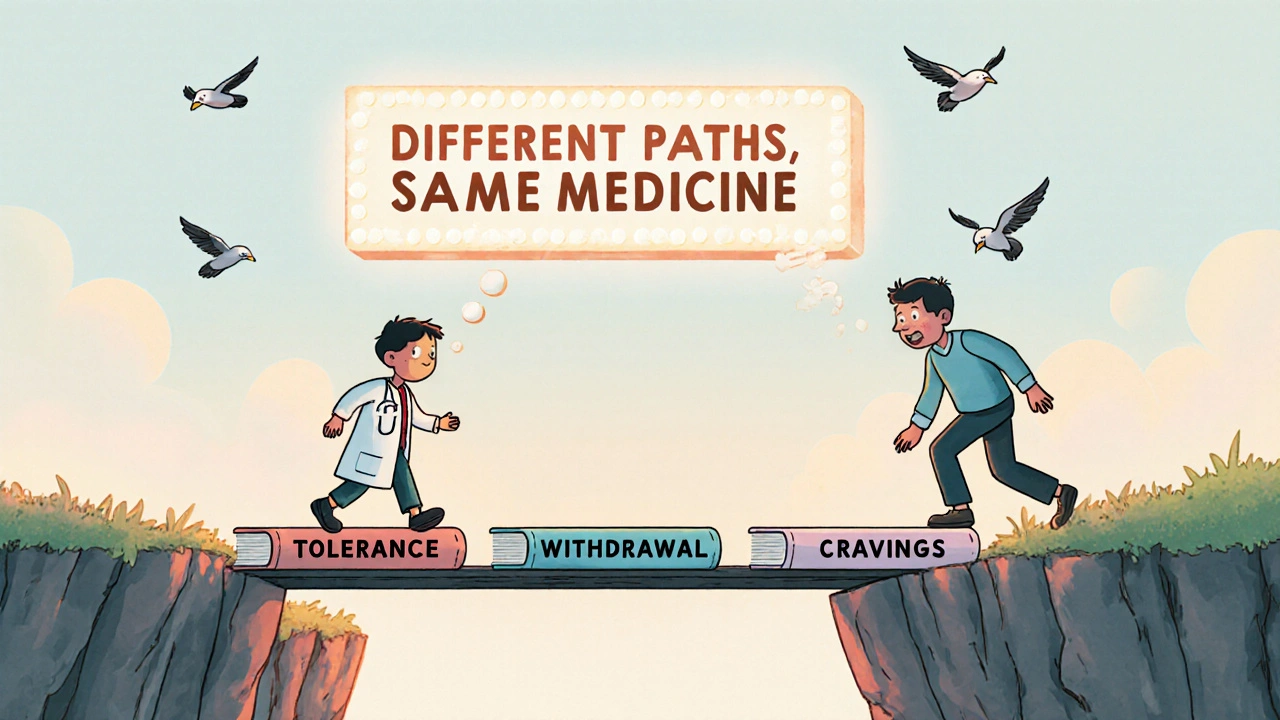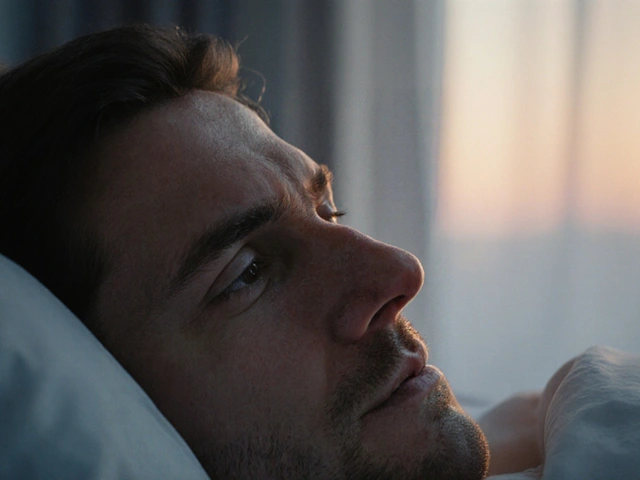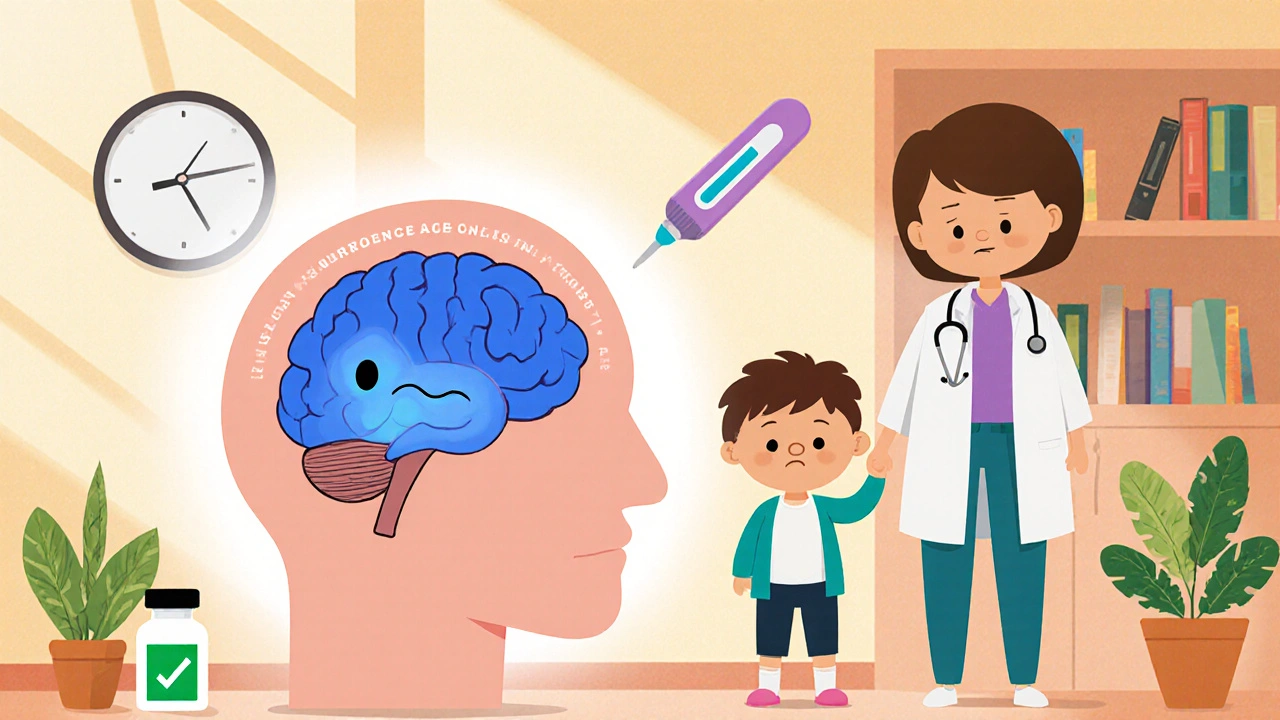Opioid Use Disorder Symptom Checker
This tool helps you understand the difference between physical dependence and Opioid Use Disorder (OUD). According to the article, physical dependence is a normal physiological response to opioids and not a sign of addiction. OUD involves specific behavioral patterns and is diagnosed when you have at least two symptoms from the DSM-5 criteria listed below.
The CDC states: "Physical dependence is not a reason to discontinue opioid therapy when benefits outweigh risks." Answer the questions below to learn about your symptoms and what they might mean.
DSM-5 Criteria for Opioid Use Disorder
Check the symptoms you experience. The DSM-5 defines Opioid Use Disorder when you have at least two of these symptoms in a 12-month period:
When someone takes opioids for pain, they might start feeling sick if they miss a dose. Their stomach churns, they sweat, they can’t sleep. Many assume this means they’re addicted. But that’s not true. What they’re experiencing is physical dependence - a normal, predictable response to the medicine, not a sign of addiction. Confusing the two has led to real harm: patients being denied pain relief, doctors fearing prescriptions, and people feeling ashamed for needing medication they were prescribed.
What Is Physical Dependence?
Physical dependence happens when your body adapts to a drug over time. With opioids, this means your brain changes how it regulates things like breathing, heart rate, and stress response. It’s not about craving or loss of control. It’s biology.After just 7 to 10 days of daily opioid use - even at low doses like 30 morphine milligram equivalents (MME) per day - your body adjusts. You don’t feel the drug’s effects the same way anymore. That’s tolerance. And if you suddenly stop, your body goes into overdrive. Withdrawal kicks in.
Common withdrawal symptoms include:
- Nausea (92% of cases)
- Vomiting (85%)
- Profuse sweating (78%)
- Anxiety (89%)
- Yawning (76%)
- Diarrhea (68%)
These aren’t signs of moral failure. They’re signs your nervous system is recalibrating. The Clinical Opiate Withdrawal Scale (COWS) measures this severity. A score above 12 means moderate withdrawal - manageable with medical support, not punishment.
Physical dependence is so common that nearly 100% of people taking opioids daily for more than 30 days develop it. That’s not a red flag. It’s a footnote in the medical record. The CDC explicitly states: “Physical dependence is not a reason to discontinue opioid therapy when benefits outweigh risks.”
What Is Addiction - or Opioid Use Disorder?
Addiction is not the same thing. In clinical terms, it’s called Opioid Use Disorder (OUD), and it’s a brain disease. It’s not about how much you take or how long you’ve been on it. It’s about what you do despite the consequences.The DSM-5, the standard diagnostic manual used by doctors, defines OUD by 11 specific behaviors. You need at least two in a 12-month period. These aren’t vague feelings - they’re observable actions:
- Craving the drug (present in 83% of severe cases)
- Using more than intended
- Failing to cut down despite wanting to
- Spending large amounts of time getting, using, or recovering from the drug
- Giving up important activities because of use
- Continuing use even when it harms your health, job, or relationships
- Needing higher doses to get the same effect (tolerance)
- Experiencing withdrawal symptoms
Notice something? Tolerance and withdrawal - the same things that define physical dependence - are listed here too. But they’re not enough on their own. OUD requires compulsive behavior, loss of control, and harm.
Studies show that while almost everyone who takes opioids long-term becomes physically dependent, only about 8% develop OUD. That’s a critical difference. In 2017, 9.9 million Americans misused prescription painkillers - but only 1.7 million met the clinical criteria for OUD.
How the Brain Changes: Dependence vs Addiction
The difference isn’t just behavioral - it’s neurological.Physical dependence is tied to the locus coeruleus, a brainstem area that controls alertness and stress. Opioids calm it down. Over time, it overcompensates. When you stop, it fires wildly - causing shakes, sweats, and nausea. This system resets in weeks.
Opioid Use Disorder, however, rewires the reward system. It hits the ventral tegmental area and nucleus accumbens - the brain’s pleasure center. Dopamine surges from drug use create a powerful signal: “This is survival.” Meanwhile, the prefrontal cortex - the part that makes rational decisions - weakens. Imaging studies show up to a 30% drop in activity here during impulse control tasks.
That’s why someone with OUD will lie, steal, or risk arrest to get more pills - even after losing their job, family, or health. It’s not greed. It’s brain chemistry. These changes can last years, even after stopping use. That’s why relapse is common.
Dr. Nora Volkow, head of the National Institute on Drug Abuse, puts it simply: “Physical dependence is a normal physiological adaptation. Addiction reflects pathologic changes in brain circuits that govern motivation and behavior.”
Why the Confusion Exists - and Why It’s Dangerous
A 2020 study found that 68% of chronic pain patients on opioids believed withdrawal meant they were addicted. That fear drives people to quit cold turkey - sometimes with deadly results.One patient on Reddit wrote: “I tapered off 60 MME/day oxycodone over eight weeks. Had withdrawal for 10 days. Never felt the urge to use recreationally. I just needed it to walk.”
Another, with OUD, said: “I stole money from my mom. Drove two hours to get more pills. Lost my job. Still couldn’t stop.”
These aren’t just stories. They’re evidence of a systemic problem. Because doctors were taught to equate dependence with addiction, many stopped prescribing opioids altogether after the 2016 CDC guidelines. Prescriptions dropped 44%. But overdose deaths didn’t fall - they spiked. Illicit fentanyl filled the void.
The American Medical Association passed a resolution in 2021 urging doctors to “distinguish between physical dependence and substance use disorder to prevent inappropriate discontinuation of medically necessary opioid therapy.” The CDC’s 2022 update reinforced this: “Physical dependence should not be confused with addiction.”
How Doctors Tell the Difference
There’s no single blood test. Diagnosis comes from behavior, history, and tools.For risk assessment, many clinics use the Opioid Risk Tool (ORT). It flags patients with a history of substance misuse, mental illness, or family addiction as high-risk - about 24% of users. But even high-risk patients can take opioids safely with monitoring.
For physical dependence, the goal is safe tapering. The CDC recommends reducing doses by 5-10% every 2-4 weeks. Slower if the dose is over 100 MME/day. Withdrawal symptoms are managed with medications like clonidine or the newer lofexidine - not ignored.
For OUD, tapering isn’t enough. You need Medication-Assisted Treatment (MAT). That means buprenorphine or methadone - drugs that stabilize the brain without causing euphoria - paired with counseling. MAT cuts overdose death risk by 50-80%.
Screening tools like the DSM-5 criteria have 94% accuracy when used by trained providers. But too often, doctors skip the interview. They see withdrawal and assume addiction. That’s a mistake.

What This Means for Patients
If you’re on opioids for chronic pain and feel sick when you miss a dose - you’re not addicted. You’re dependent. That’s okay. That’s normal. Talk to your doctor about a taper plan. Don’t quit on your own.If you’re using opioids beyond what’s prescribed, hiding use, or continuing despite job loss, relationship breakdowns, or health decline - you might have OUD. That’s not weakness. It’s a medical condition. And it’s treatable.
There’s no shame in needing medication. There’s also no shame in needing help to stop using it compulsively. The goal isn’t to scare people away from pain relief. It’s to ensure people get the right care - whether that’s pain management or addiction treatment.
What’s Changing Now
New research is making it easier to tell the difference. A 2023 study in the Journal of Neuroscience used fMRI scans to measure brain activity during cravings. They could distinguish physical dependence from OUD with 89% accuracy by looking at prefrontal cortex function.That’s not in clinics yet - but it’s coming. In the next 3-5 years, brain scans may become part of routine diagnosis.
Meanwhile, the NIH has invested $1.8 billion into non-addictive pain treatments. Insurance companies now cover MAT for OUD in 98% of cases. But only 67% have clear protocols for managing physical dependence in chronic pain patients.
The message from experts is clear: stop treating dependence like a crisis. Start treating it like a side effect. And start treating OUD like the brain disease it is - not a moral failing.
Can you be physically dependent on opioids without being addicted?
Yes. Nearly everyone who takes opioids daily for more than a month becomes physically dependent. That means they’ll experience withdrawal if they stop suddenly. But physical dependence doesn’t mean they crave the drug, use it compulsively, or harm themselves or others to get it - which are the hallmarks of addiction or Opioid Use Disorder.
Does physical dependence mean I need to stop taking my pain medication?
No. The CDC and major medical groups state that physical dependence alone is not a reason to stop opioid therapy. If your medication is helping you manage pain and you’re not showing signs of addiction, continuing treatment is appropriate. Stopping abruptly can cause dangerous withdrawal and worsen pain. Work with your doctor on a safe taper plan if needed.
How do I know if I have Opioid Use Disorder?
Opioid Use Disorder is diagnosed when you have at least two of 11 specific behaviors in a 12-month period - like using more than intended, failing to cut down, spending excessive time getting or using opioids, continuing use despite harm to relationships or health, or having strong cravings. Physical dependence (withdrawal symptoms) is one of those symptoms, but it’s not enough on its own. A trained clinician uses the DSM-5 criteria to make this diagnosis.
Can you get addicted to opioids if you take them exactly as prescribed?
It’s possible, but rare. Studies show that among opioid-naïve patients taking opioids strictly for acute pain after surgery, only 0.7-1.0% develop Opioid Use Disorder. Risk increases with longer use, higher doses, or a personal or family history of substance misuse. But taking opioids as directed - with regular check-ins and no misuse - keeps risk very low.
What’s the difference between tolerance and addiction?
Tolerance means you need higher doses to get the same effect - it’s a sign your body has adapted. That’s common with long-term opioid use and doesn’t mean you’re addicted. Addiction involves loss of control, compulsive use despite harm, and cravings. You can have tolerance without addiction. But addiction almost always includes tolerance.
Is Medication-Assisted Treatment (MAT) just replacing one drug with another?
No. MAT uses medications like buprenorphine or methadone to stabilize brain chemistry, reduce cravings, and block the effects of other opioids - without causing euphoria. It’s like using insulin for diabetes or blood pressure meds for hypertension. MAT reduces overdose deaths by 50-80% and helps people regain stability to engage in counseling and rebuild their lives. It’s evidence-based treatment, not substitution.






12 Comments
Been on oxycodone for 3 years for back pain. Withdrawal felt like dying, but I never craved it outside of managing pain. Guess I'm just biologically inconvenient.
Let’s be honest - the medical establishment has spent decades weaponizing fear against patients who need opioids, all while ignoring the neurobiological truth that dependence ≠ addiction. This isn’t just semantics; it’s a moral crisis wrapped in clinical jargon. We’ve pathologized survival. We’ve turned physiological adaptation into a character flaw. The DSM-5 doesn’t care about your dignity - it cares about checkboxes. And yet, here we are, still treating chronic pain patients like potential addicts because someone in a boardroom decided that fear sells better than compassion. The real addiction? The system’s addiction to punishment over care.
Neurologically, the locus coeruleus hyperactivity during withdrawal is well-documented - glutamatergic rebound, norepinephrine surge, all of it. But what’s rarely discussed is how the prefrontal cortex’s hypofunction in OUD creates a feedback loop where executive control is chronically impaired. Tolerance and withdrawal are homeostatic responses; OUD is a circuit-level rewiring. The 30% drop in PFC activity during impulse tasks isn’t just correlation - it’s causation. We’re not talking about willpower. We’re talking about neuroplasticity gone rogue.
Thanks for laying this out clear. I’ve seen too many people quit cold turkey because they thought dependence meant they were weak. Just last week a friend told me he stopped his meds because his doctor said he was 'at risk.' No taper. No support. Just fear. We need better education - for docs and patients alike. Simple stuff. Like, 'this is normal, here’s how to manage it.' No drama. Just facts.
In India, we don’t have this luxury - opioids are either banned or sold on the black market. But I’ve seen men cry because they can’t get pain relief after surgery. And then we have Westerners who think dependence is a moral failure? Please. If you’ve ever had a broken spine and couldn’t walk - you’d understand. This isn’t about addiction. It’s about dignity. And if your country can’t give that to its people, then your guidelines are broken, not your patients.
Everyone’s acting like this is some groundbreaking revelation. Newsflash: doctors have known this since the 90s. The problem isn’t ignorance - it’s laziness. You want to avoid paperwork? Just say 'addiction' and cut them off. Easier than monitoring, than tapering, than dealing with insurance. So now we have people dying from fentanyl because they were scared to ask for help. This isn’t science. It’s systemic cowardice.
Let’s not pretend this is about science. This is about class. The people getting cut off? Poor, disabled, elderly. The people getting buprenorphine? White, insured, connected. The system doesn’t care about your brain chemistry - it cares about your zip code. You think the CDC really wants to fix this? Nah. They want to look like they’re 'doing something.' Meanwhile, the real victims are the ones left screaming in the dark.
I’m a nurse. Saw a 72-year-old woman cry because she couldn’t walk to the bathroom without her 15mg oxycodone. Her doctor told her she was 'at risk of addiction.' She’d been on it for 8 years. No misuse. No cravings. Just pain. We need to stop letting fear override care. This isn’t rocket science.
It’s fascinating how the medical community has spent decades pathologizing human physiology while simultaneously refusing to acknowledge the psychological mechanisms of addiction as a distinct neurochemical phenomenon. The conflation of dependence with disorder is not merely a semantic error - it is an epistemological failure rooted in the medicalization of moral judgment. One cannot reduce complex neurobehavioral adaptations to binary categories without committing a category error of the highest order. The DSM-5, while statistically robust, remains a flawed instrument when wielded by clinicians who lack neuropsychological literacy. This is not about pills - it is about the collapse of clinical reasoning in the face of cultural panic.
My dad was on morphine for pancreatic cancer. He didn’t want to stop. His doctor said, 'You’re dependent - that’s fine, but we’ll taper you.' No shame. No judgment. Just care. That’s how it’s supposed to work. Why does it feel like we’ve forgotten how to be human?
Just read this after my last doctor visit. I’ve been on 40 MME for 18 months. Withdrawal was brutal - but I didn’t lie, steal, or lose my job. I just needed to walk. I’m not broken. I’m just… alive. Thank you for writing this.
And yet, here we are - 12 comments deep, all nodding along like this is some new revelation. The truth? The system still won’t change. Because fixing this means admitting they were wrong. And nobody likes to be wrong.